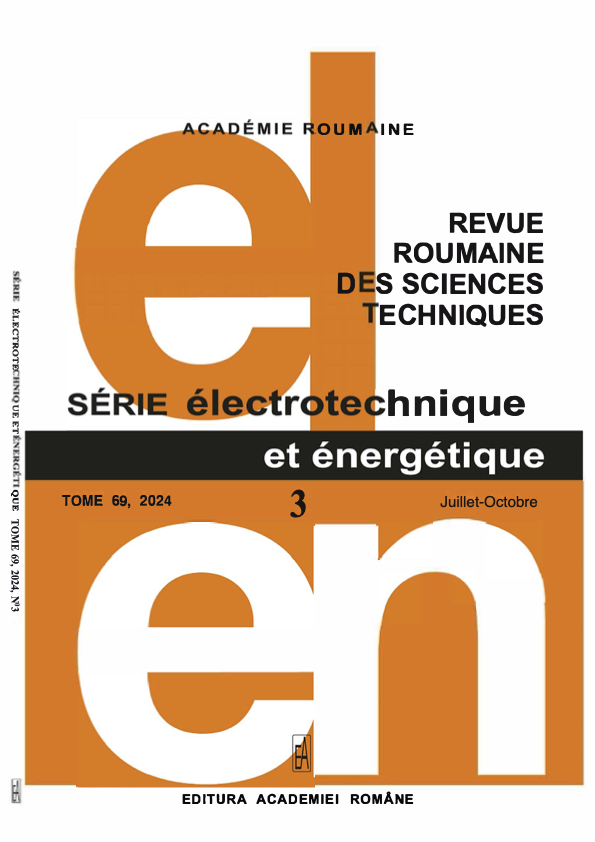EXPERIMENTAL ASSESSMENT OF CONSUMER UNBALANCE AND NONLINEARITY EFFECTS IN THREE-PHASE NETWORKS WITHOUT NEUTRAL CONDUCTOR
DOI:
https://doi.org/10.59277/RRST-EE.2024.69.3.5Keywords:
Power grid, Active power, Reactive power, Unbalanced consumers, Distorting consumers, Țugulea power theory, Powers of symmetry, Powers of non-symmetry, Residual (distorting) powersAbstract
The present study proposes a feedforward angle droop strategy based on a discrete-time mathematical model for operation dispatchable distributed generation (DG) units connected directly or through voltage source converters (VSC) to the microgrid. These units should supply their local and common loads. Droop coefficients should be increased to improve power division between different DG units. Also, a time delay in systems’ state variables and controller input is a disruptive parameter for the control system's performance. These two parameters have negative effects on network stability. To ensure the stability of the closed-loop system, a predictive sliding mode controller can be used based on discrete-time systems. However, this strategy cannot reduce the chattering phenomenon. This paper discusses the effect of time delay and increases in droop angle coefficients on the whole system and how these impacts can be eliminated. So, a combination of integral sliding mode controller (ISMC), composite nonlinear feedback (CNF), and sliding mode learning control (SMC), which is called hybrid SMC, is used with an angle droop controller.
References
(1) R. Thankakan, E.-R.-S. Nadar, A novel DC-DC converter fed by PV source employing improved incremental conductance algorithm under partial shadow conditions, Rev. Roum. Sci. Techn.–Électrotechn. et Énerg., 67, 2, pp. 145–150 (2022).
(2) K. Benmouiza, Nonlinear clustered adaptive-network-based fuzzy inference system model for hourly solar irradiation estimation, Rev. Roum. Sci. Techn.–Électrotechn. et Énerg., 68, 1, pp. 7–11 (2023).
(3) F. Amrane, A. Chaiba, B. François, Improved adaptive nonlinear control for variable speed wind-turbine fed by direct matrix converter, Rev. Roum. Sci. Techn.–Électrotechn. et Énerg., 68, 1, pp. 58–64 (2023).
(4) G. Shahgholian, S.M.A. Zanjani, A study of voltage sag in distribution system and evaluation of the effect of wind farm equipped with doubly-fed induction generator, Rev. Roum. Sci. Techn.–Électrotechn. et Énerg., 68, 3, pp. 271–276 (2023).
(5) Y. Benyssaad, Nouveau modèle d'optimisation basé sur la ‘maintenance axée sur la fiabilité’des réseaux de distribution électrique (A new optimization model based on ‘reliability centered maintenance’ of electrical distribution network), Rev. Roum. Sci. Techn.–Électrotechn. et Énerg., 67, 1, pp. 27–32 (2022).
(6) N. Zidane, S. Lalouni Belaid, A new fuzzy logic solution for energy management of hybrid photovoltaic/battery/hydrogen system, Rev. Roum. Sci. Techn.–Électrotechn. et Énerg., 67, 1, pp. 21–26 (2022).
(7) A. Abbadi, F. Hamidia, Y. Chiba, Adaptive non-linear voltage controller based multivariable sliding mode extremum seeking approach applied to multi-machine power system, Rev. Roum. Sci. Techn.– Électrotechn. et Énerg., 67, 1, pp. 65–72 (2022).
(8) M. Burlacu, V. Năvrăpescu, A.-I. Chirilă, I.-D. Deaconu, Optimal reactive power management for microgrids based on photovoltaic inverters using sine-cosine algorithm, Rev. Roum. Sci. Techn.–Électrotechn. et Énerg., 67, 2, pp. 117–122 (2022).
(9) A. Ţugulea, Considerations on the energey effects of distorting regimes (in Romanian), Energetica, XXXIV, 1, pp. 27–31 (1986).
(10) A. Ţugulea, Considerations regarding energy effects in the non-symmetrical harmonic regimes of three-phase networks (in Romanian), Energetica, XXXIV, 3, pp. 121–130 (1986).
(11) A. Ţugulea, C. Golovanov, The energy effects of non-symmetrical and distorting regimes of electric power systems. Measurement possibilities, ENERG, 3, pp. 130–159,1987.
(12) A. Ţugulea, Power flows under non-sinusoidal and non-symmetric periodic and almost periodic steady states of electrical power system, Proc. of 6th Int. Conf. on Harmonics in Power Systems (ICHPS VI), Bologna, Italy, pp. 388–395 (1994).
(13) A. Ţugulea, Criteria for the definition of the electric power quality and its measurement systems, European Transactions on Electrical Power, 6, 5, pp. 357–363 (1996).
(14) C.I. Budeanu, Puissances réactives et fictives, Institut Roumain de l’Énergie, 2 (1927).
(15) H.M. Zubi, N. Hfouda, Modelling & simulation of telecom data center electrical distribution network highly penetrated with non-linear loads, IEEE 1st International Maghreb Meeting of the Conference on Sciences and Techniques of Automatic Control and Computer Engineering MI-STA, Tripoli, Libya (2021).
(16) R.M. Ciuceanu, I.V. Nemoianu, V. Mănescu (Păltânea), G. Păltânea, On Professor Ţugulea’s visionary power theory: a review, recent advances and perspectives, Roum. Sci. Techn. – Électrotechn. et Énerg., 63, 2, pp. 123–127 (2018).
(17) P.M. Nicolae, I.D. Nicolae, M.Ş. Nicolae, Powers and power factor in non-sinusoidal and non-symmetrical regimes in three-phase systems, Energies, 15, 14, pp. 1–45 (2022).
(18) B.D.H. Tellegen, A general network theorem, with applications, Philips Res. Rep., 7, pp. 259–269 (1952).
(19) I.V. Nemoianu, R. M. Ciuceanu, Non-symmetry and residual active and reactive powers flow in non-linear three-phase unbalanced circuits, Roum. Sci. Techn. – Électrotechn. et Énerg., 60, 2, pp. 227–237 (2015).
(20) I.V. Nemoianu, R. M. Ciuceanu, Characterization of non-linear three-phase unbalanced circuits powers flow supplied with symmetrical voltages, Roum. Sci. Techn. – Électrotechn. et Énerg., 60, 3, pp. 355–365 (2015).
(21) I. Şora, N. Golovanov, Electrothermic and Electrotechnology, vol. 1, Electrothermic (in Romanian), Ed. Tehnică, Bucharest (1977).
(22) I. Mircea, Electrical Installations, and Equipment (in Romanian), Editura Didactică și Pedagogică, Bucharest (1996).
(23) G. Iacobescu, I. Iordănescu, et al., Electric Networks (in Romanian), Editura Didactică și Pedagogică, Bucharest, 1981.
(24) D. Jeltsema, Budeanu’s concept of reactive and distortion power revisited, Przeglad Elektrotechniczny, 92, 4, (2016).
(25) M. Saitou, T. Shimizu, Generalized theory of instantaneous active and reactive powers in single-phase circuits based on Hilbert transform, Proc. 33rd Power Elec. Spec. Conf. (PESC), 3, pp. 1419–1424 (2002).
(26) R. G. Azevedo, L. F. Monteiro, A. J. Pires, Harmonic analysis of distribution transformers under different loading conditions, IEEE Transactions on Power Delivery, 22, 3, pp. 1479–1486 (2007).
(27) I.F. Hănţilă, M. Maricaru, F. Constantinescu, R.M. Ciuceanu, A new method for time-domain computation of steady state in nonlinear circuits, IEEE International Conference on Microwaves, Communication, Antennas and Electronics Systems (COMCAS), pp.1–6, Tel-Aviv, Israel, 7–9 Nov. (2011).
Downloads
Published
Issue
Section
License
Copyright (c) 2024 REVUE ROUMAINE DES SCIENCES TECHNIQUES — SÉRIE ÉLECTROTECHNIQUE ET ÉNERGÉTIQUE

This work is licensed under a Creative Commons Attribution-NonCommercial-NoDerivatives 4.0 International License.


